
Beginning in 1890, Canada's
Remembrance Day was called "Decoration Day" - and was commemorated in May
similar to the the USA's Memorial Day, until 1931 it was moved to November 11
by an act of parliament and renamed "Remembrance Day."
Canada's military memorial day was first observed in May 1890, long before the South African War and the
First World War.
The first commemoration was first held on the grounds of University of Toronto
across the street from Queens Park, partly in protest by
Canadian Militia veterans who had fought at the Battle of Ridgeway on June 2,
1866 defending Canada from a force of Irish-American Fenian insurgents invading from the USA
across the Niagara River at Fort Erie, and partly to remember the nine militia
soldiers from Toronto's Queen's Own Rifles Regiment who were killed in action at
Ridgeway, arguably the first Canadian casualties from the modern Canadian Armed
Forces.
It was called "Decoration Day" because fallen soldier's graves were "decorated"
with flowers.
The veterans and public had gathered at the 'Volunteers Monument' in Toronto to protest the Canadian government's lack of recognition of the veterans and remember those killed in action at Ridgeway, Canada's first "modern battle", one first fought in the age of the telegraph, steam power, rifled barrels, a free press and parliamentary democracy in Canada ("Responsible Government.)
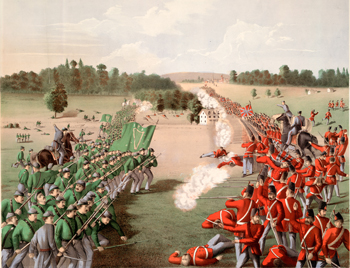 On June 1,
1866, after nearly fifty years of peace since the War of 1812, Canada was
invaded from the United States by an insurgent army of Irish-American Fenians
determined to expel British rule from Ireland by taking Canada hostage.
A 1,000 man heavily armed vanguard of battle
hardened Civil War veterans from the US and former Confederate army seized the town of
Fort Erie and began moving towards the Welland Canal next, threatening to
destroy it.
On the morning of June 2, near the village of Ridgeway west of Fort Erie, they were
intercepted by a brigade of Canadian militia from the Queen’s Own Rifles (QOR)
of Toronto and 13th Battalion of Hamilton (today the Royal Hamilton
Light Infantry (RHLI) in what became Canada’s first modern battle to be fought
exclusively by Canadian troops and led entirely by Canadian officers:
the Battle of Ridgeway.
On June 1,
1866, after nearly fifty years of peace since the War of 1812, Canada was
invaded from the United States by an insurgent army of Irish-American Fenians
determined to expel British rule from Ireland by taking Canada hostage.
A 1,000 man heavily armed vanguard of battle
hardened Civil War veterans from the US and former Confederate army seized the town of
Fort Erie and began moving towards the Welland Canal next, threatening to
destroy it.
On the morning of June 2, near the village of Ridgeway west of Fort Erie, they were
intercepted by a brigade of Canadian militia from the Queen’s Own Rifles (QOR)
of Toronto and 13th Battalion of Hamilton (today the Royal Hamilton
Light Infantry (RHLI) in what became Canada’s first modern battle to be fought
exclusively by Canadian troops and led entirely by Canadian officers:
the Battle of Ridgeway.
Nine riflemen from the Queen's Own Rifles, three of them University of Toronto
student volunteers hastily called out
from their final exams on the day before, were killed in the battle before the
Canadian forces were forced to fall back by the more experienced and better
armed Fenian insurgents. Twenty-two more
Canadians would die of either wounds or disease sustained during the fighting or
on frontier duty during the Fenian Raids that would also extend into Quebec in
the following week.
Beginning with the first casualty, Ensign Malcolm McEachern killed in the
early minutes of the battle on June 2, these thirty-one casualties were the
first 31 of nearly 120,000 Canadian servicemen to fall in military service from the South
African War to Afghanistan.
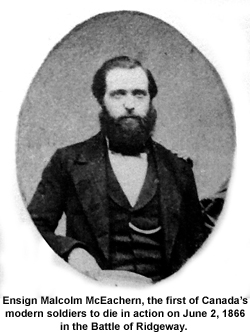 Except for
miniscule payments to those severely wounded in the battle, or to the widows and
orphans of those killed, the veterans
received from the government no acknowledgement, no honours, decorations, pensions or awards for their
service in the defence of Canada during the Fenian Raids.
The
Canadian Volunteers Monument,
raised in 1870 near Queens Park (Toronto's currently oldest standing public monument)
was paid for entirely by private donations. As Canadian-American relations
warmed towards the mutual "undefended border" further public discourse or
commemoration of
a battle defending against an invasion from across the U.S. border became
unpolitic, inconvenient and impolite.
The more than eight hundred veterans who fought at Ridgeway were forgotten and
ignored for twenty-five years following the battle.
Except for
miniscule payments to those severely wounded in the battle, or to the widows and
orphans of those killed, the veterans
received from the government no acknowledgement, no honours, decorations, pensions or awards for their
service in the defence of Canada during the Fenian Raids.
The
Canadian Volunteers Monument,
raised in 1870 near Queens Park (Toronto's currently oldest standing public monument)
was paid for entirely by private donations. As Canadian-American relations
warmed towards the mutual "undefended border" further public discourse or
commemoration of
a battle defending against an invasion from across the U.S. border became
unpolitic, inconvenient and impolite.
The more than eight hundred veterans who fought at Ridgeway were forgotten and
ignored for twenty-five years following the battle.
In May 1890 after nearly
two and a half decades of silence, a short paragraph in the
Globe, “Ridgeway Remembered,” reported that the
Veterans of ’66 Association had “taken the
matter in hand” and would meet
in protest
on the
twenty-fourth anniversary of the battle to lay flowers
and wreaths
at the
Canadian Volunteers Monument
near Queen’s Park.[1]
The
Globe described the
occasion
under the headline “Our Decoration Day” and
promised that from now on the day
would be commemorated annually in the same
way that Americans memorialize their war dead.[2]
The next year in
Hamilton, it was reported that the Ridgeway veterans of the Thirteenth Battalion
had come together for a reunion for the first time in twenty-five years.[3]
The national memorialization of Ridgeway had begun and would now unfold from
about 1890 to1925, resulting in a thirty-five year renaissance of
acknowledgments, awards, speeches, ceremonies, reminiscences, and published
accounts, some sponsored by regional historical societies.
On June 2, 1891 in Toronto, the twenty-fifth
anniversary of the battle, thirty thousand people gathered at the
Volunteers Monument. Spectators
climbed up on the scaffolding of the newly constructed Parliament Buildings onto
lumber piled up at the site and into the trees of the park. Schoolchildren covered the monument in
wreaths and leafy plants,
some bearing the names of those killed at Ridgeway.
Not a practice followed in Britain at the time, this was a
gesture adopted from the United States where, after the Civil War, flowers were
laid on military graves in May on national Memorial Day, or Decoration Day, as
it was also known.
Toronto’s militia
regiments, along with 450 boys from the public school drill corps carrying
muskets and accompanied by 30 Toronto Police constables, escorted several
hundred Veterans of ’66 from the drill shed at Simcoe Street along a route
packed with fifty thousand spectators.[4]
The
“decoration” of the monument by Toronto’s schoolchildren became an annual
ritual. It was the beginning of
Canada’s
first remembrance day.[5]
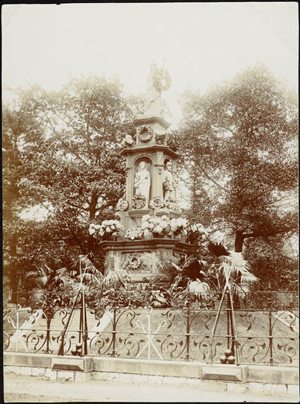 Decoration
Day would eventually encompass the remembrance of those who died in the
1885
Northwest Rebellion[6] and later
the
South African War
1899-1903,
with the first joint remembrance ceremony being held in
June 1903.[7]
Throughout the Great War (First World War) the mounting casualties were mourned
on Decoration Day in June long before there came to be a November 11 armistice
in 1918.
Decoration
Day would eventually encompass the remembrance of those who died in the
1885
Northwest Rebellion[6] and later
the
South African War
1899-1903,
with the first joint remembrance ceremony being held in
June 1903.[7]
Throughout the Great War (First World War) the mounting casualties were mourned
on Decoration Day in June long before there came to be a November 11 armistice
in 1918.
Until 1931, Decoration Day
was Canada’s
popular national
memorial day, held in late May or early June and in some places as late
as August.[8]
It is still commemorated today in some of the Ontario rural communities that
witnessed the Fenian Raids or saw their sons die or be broken in them. In 2010
the town of Dunnville held its 113th annual Decoration Day on June 6,[9]
while Caledonia held its own on May 30.[10]
By 1895 the Veterans of ’66 Association had organized a national petition for the recognition of all the volunteers who served during the Fenian Raids.[11] In January 1899, in response to the petition, Britain authorized a Canadian General Service Medal for veterans of the 1866 and 1870 Fenian Raids and the 1870 Red River Rebellion. Anybody who was on active service in the field, had served as a guard at any point when an attack from the enemy was expected, or had been detailed for some specific service or duty was eligible for the medal upon applying for it—it was not issued automatically. There were 15,300 of these medals issued to Canadians with their individual names and units engraved on the rim. (Another 1,368 were claimed by British veterans.)[12] The medal was issued by Britain just in time for the call on Canada to help in the upcoming South African War. The Canadian federal government acquiesced to the British medal but added nothing of its own for the veterans of Ridgeway as it did in the case of the Red River Expedition and Northwest Rebellion, whose veterans were granted 160 acres of Crown land, whereas those who fought in South Africa would get 320 acres.[13] In the end, in 1901 the province of Ontario undertook to grant its Fenian Raid veterans 160 acres of provincial land if they applied for it.[14]
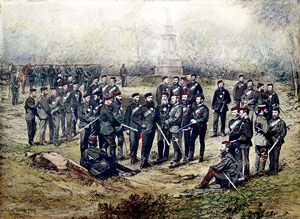 While
the medals and recognition might have healed some hurt pride, the process of
historical restoration was incomplete. The public events were accompanied by
newspaper articles on the histories of the battle and on the units who fought in
it. Over the next two decades, witnesses and veterans of the battle began
publishing their recollections in popular magazines and historical journals and
in papers presented at historical society talks.[15]
But these fragmentary sources were never assembled or collated in any new
comprehensive history of the battle other than the one authored by Captain John
A. Macdonald in 1910. His book, Troublous
Times in Canada: The History of the Fenian Raids of 1866 and 1870, would be
the last on the battle for more than a century to follow. It added nothing new
but lamented how, “It is a strange fact that Canadian authors and historians do
not seem to have fully realized the gravity of the situation that then existed,
as the event has been passed over by them with the barest possible mention. Thus
the people of the present generation know very little of the Fenian troubles of
1866 and 1870, and the great mass of the young Canadian boys and girls who are
being educated in our Public Schools and Colleges are in total ignorance of the
grave danger which cast dark shadows over this fair and prosperous Dominion in
those stormy days.”[16]
Nothing had
changed in the hundred years
since those
words had been written which is why the author of this article researched and
wrote Ridgeway in 2011.
While
the medals and recognition might have healed some hurt pride, the process of
historical restoration was incomplete. The public events were accompanied by
newspaper articles on the histories of the battle and on the units who fought in
it. Over the next two decades, witnesses and veterans of the battle began
publishing their recollections in popular magazines and historical journals and
in papers presented at historical society talks.[15]
But these fragmentary sources were never assembled or collated in any new
comprehensive history of the battle other than the one authored by Captain John
A. Macdonald in 1910. His book, Troublous
Times in Canada: The History of the Fenian Raids of 1866 and 1870, would be
the last on the battle for more than a century to follow. It added nothing new
but lamented how, “It is a strange fact that Canadian authors and historians do
not seem to have fully realized the gravity of the situation that then existed,
as the event has been passed over by them with the barest possible mention. Thus
the people of the present generation know very little of the Fenian troubles of
1866 and 1870, and the great mass of the young Canadian boys and girls who are
being educated in our Public Schools and Colleges are in total ignorance of the
grave danger which cast dark shadows over this fair and prosperous Dominion in
those stormy days.”[16]
Nothing had
changed in the hundred years
since those
words had been written which is why the author of this article researched and
wrote Ridgeway in 2011.
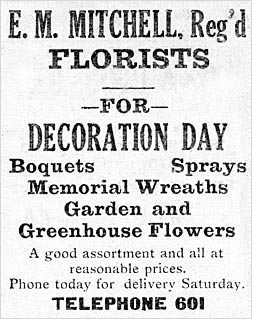 In the early 1900s, mention of “Decoration Day” began to fade from the
newspapers.
By 1903 the commemoration coverage in the
Globe was reduced once again to a
small paragraph, and by 1907 the event had been moved to the privacy of the
cemeteries where the fallen were buried. It was no longer the public event it
had been in the 1890s and gradually became disconnected from June 2 and moved
closer to Victoria Day in May. After years of peace following the South African
War, the Great War of 1914 to 1918 sadly revived Decoration Day as Canada’s
national memorial day.
In the early 1900s, mention of “Decoration Day” began to fade from the
newspapers.
By 1903 the commemoration coverage in the
Globe was reduced once again to a
small paragraph, and by 1907 the event had been moved to the privacy of the
cemeteries where the fallen were buried. It was no longer the public event it
had been in the 1890s and gradually became disconnected from June 2 and moved
closer to Victoria Day in May. After years of peace following the South African
War, the Great War of 1914 to 1918 sadly revived Decoration Day as Canada’s
national memorial day.
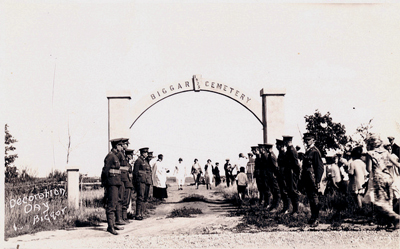 In
1916, on the fiftieth anniversary of Ridgeway the cornerstone for a monument was
laid at a five-acre site on the Garrison Road end of the battlefield,
approximately where the schoolhouse stood and where the ridge began its rise
toward the north. In 1921 the site was made a National Historic Battlefield to
be administrated by Parks Canada with a cairn to mark the spot. One of the
surviving cabins that was used during the battle as a field hospital and in
which Canada’s
first military casualties were treated, was relocated to the site. Farther down the road
in the town of Ridgeway are a battlefield museum and Fort Erie’s historical
archives. The battlefield itself, east of Ridge Road between Garrison and Bertie
roads, until very recently had remained untouched, although the orchards had
long disappeared, but it is now facing extinction under creeping housing
developments.
In
1916, on the fiftieth anniversary of Ridgeway the cornerstone for a monument was
laid at a five-acre site on the Garrison Road end of the battlefield,
approximately where the schoolhouse stood and where the ridge began its rise
toward the north. In 1921 the site was made a National Historic Battlefield to
be administrated by Parks Canada with a cairn to mark the spot. One of the
surviving cabins that was used during the battle as a field hospital and in
which Canada’s
first military casualties were treated, was relocated to the site. Farther down the road
in the town of Ridgeway are a battlefield museum and Fort Erie’s historical
archives. The battlefield itself, east of Ridge Road between Garrison and Bertie
roads, until very recently had remained untouched, although the orchards had
long disappeared, but it is now facing extinction under creeping housing
developments.
On June 1, 1930, eight surviving Ridgeway veterans in their eighties marched in St. Catharines in the last Decoration Day parade to be held there.[17] After that they came no more. On November 9, 1936, the Hamilton Spectator noted that “the last but one” of the remaining Fenian Raid veterans from the Thirteenth Battalion, Thomas Kilvington, had died. Allan Land, ninety-two years old, was the only one left standing of the “boys” from Hamilton.[18]
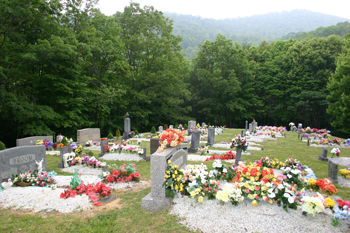 Following the First World
War, Decoration Day in late May or early June (and even as late as August in
some communities) had continued to be Canada’s
national memorial day for all veterans until an Act of Parliament in 1931, in
order to "harmonize it with Commonwealth practice"
transformed November 11 "Armistice Day" into "Remembrance Day" while
Thanksgiving Day was moved back a month to October.[19] The
Ridgeway veterans, of whom those still living were aged men, were forgotten and excluded from the new Remembrance Day, the
honour extended by Veterans Affairs Canada only as far back as 1899, to those who
fought in the South African War.[20]
At this writing, the fallen of Ridgeway are not listed in Canada’s National
Books of Remembrance and their graves scattered across Ontario, the land they
defended with their lives, remain
forgotten and uncared for by the government, abandoned without national historic
monument status or as Canadian war graves.[21]
Following the First World
War, Decoration Day in late May or early June (and even as late as August in
some communities) had continued to be Canada’s
national memorial day for all veterans until an Act of Parliament in 1931, in
order to "harmonize it with Commonwealth practice"
transformed November 11 "Armistice Day" into "Remembrance Day" while
Thanksgiving Day was moved back a month to October.[19] The
Ridgeway veterans, of whom those still living were aged men, were forgotten and excluded from the new Remembrance Day, the
honour extended by Veterans Affairs Canada only as far back as 1899, to those who
fought in the South African War.[20]
At this writing, the fallen of Ridgeway are not listed in Canada’s National
Books of Remembrance and their graves scattered across Ontario, the land they
defended with their lives, remain
forgotten and uncared for by the government, abandoned without national historic
monument status or as Canadian war graves.[21]
ENDNOTES
[1]
Globe, May 31, 1890.
[2]
Globe, June 3, 1890.
[3]
Hamilton Spectator, June 3, 1891.
[4]
Globe, June 3, 1891.
[5]
Paul Maroney, “‘Lest We Forget’: War and Meaning in English Canada,
1885–1914,” Journal of Canadian Studies, Vol. 32, No. 4 (Winter 1997/1998);
Globe, May 30, 1896.
[6]
Globe, May 30, 1896.
[7]
Maroney, “‘Lest We Forget.’”
[8]
http://www.vac-acc.gc.ca/remembers/sub.cfm?source=teach_resources/remdayfact
[retrieved January 2, 2010].
[9]
Cathy Pelletier, “Decoration Day in Dunnville,”
The Chronicle, June 8, 2010,
http://www.dunnvillechronicle.com/ArticleDisplay.aspx?e=2614364
[accessed July 6, 2010].
[10]
Katie Dawson, “Honouring Veterans During Decoration Day Ceremony,”
Cambridge Reporter, May 19,
2010, http://www.cambridgereporter.com/news/article/210556 [accessed
July 6, 2010].
[11]
Globe, March 11, 1896; April 12, 1897; May 24, 1897; Captain
Macdonald, p. 185; Committee of Citizens Chosen to Represent the City of
Toronto, “To The Queen’s Most Excellent Majesty,” circa 1897 [CIHM NNo.
46333].
[12]
http://www.vac-acc.gc.ca/remembers/sub.cfm?source=collections/cmdp/mainmenu/group03/cgsm
[retrieved Oct. 10, 2009].
[13]
Captain Macdonald, pp. 186–188.
[14]
RG 1-99 Fenian land grant records, Archives of Ontario
[15]
Globe, July 4, 1896, and January 7, 1899;
Canadian Magazine, November, December 1897, January 1898, July 1899.
[16]
Captain Macdonald, p. 5.
[17]
Globe, June 2, 1930.
[18]
Hamilton Spectator, November 9, 1936.
[19]
http://www.vac-acc.gc.ca/general/sub.cfm?source=teach_resources/remdayfact
and
www.calendar-updates.com/info/holidays/canada/remembrance.aspx
[retrieved October 10, 1866]. James Wood argues that the militia lobbied in
the 1890s to move Thanksgiving Day to October for the Canadian holiday
in the hopes of enjoying better weather and larger audiences for its
church parade. See James Wood, Militia Myths: Ideas of the Canadian
Citizen Soldier 1896–1921, Vancouver-Toronto: University of British
Columbia Press, 2010. p. 30.
[20]
http://www.vac-acc.gc.ca/remembers/sub.cfm?source=teach_resources/remdayfact
[retrieved January 7, 2010].